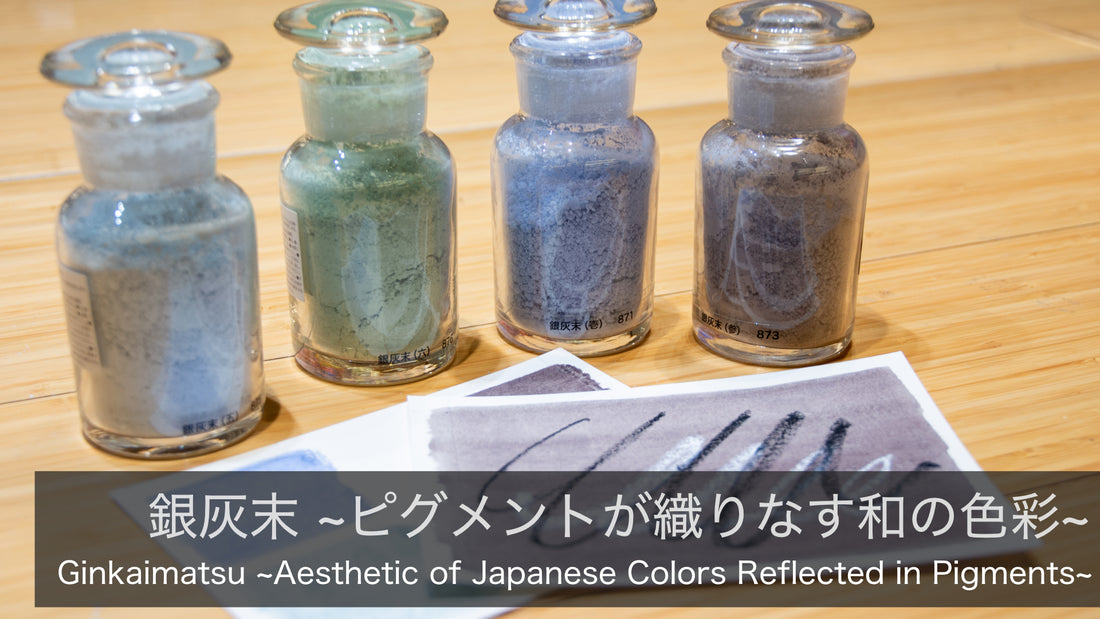What kind of painting materials first come to your mind when you think of Nihonga, also known as Japanese painting?
One of the most popular pigments for Japanese painting is Gunjo, derived from natural azurite. If you compare it to synthetic ultramarine blue, you can tell there is a significant difference in texture.
Another characteristic of this type of pigment is the numbering according to the size of their particles.
The finer the particles, the more light is diffusely reflected, resulting in increased brightness of the colors.
The unique matte finish and grainy texture of Japanese painting are created by these color materials.
Unlike pigments in general, this type of pigment does not cover and hide the color underneath, so it is required to give several coats with the same pigment. Furthermore, since the specific gravity of each pigment differs due to the material made of, different colors are often not blended well and separated on a palette even though they are labeled with the same number. And also, the number of pigments derived from natural minerals is quite limited as well.
For those reasons, sometimes plant-derived dyes which have numerous color variations have been mixed with Gofun (oyster shell) powder to create pigments. This kind of pigment is called Gu-enogu and is often used with mineral pigments in Japanese painting.
It creates a more opaque and matte finish compared to mineral pigments.
As you can see here, artists have been seeking more colors for painting through various trials and errors throughout history.
Suihi is another type of pigment that is also made by tinting Gofun and drying it in a plate form.
Other color materials used like Suihi are Earth pigments, vermilion, and cochineal dye. Furthermore, “Ginkaimatsu” is one of these pigments and they come in six colors.
Ginkaimatsu pigments are made by blending mineral pigments and other pigments, thus their color palettes are unique and not found in mineral pigments.
Since the description of the pigment says it contains antimony compounds, it means its material is metal-based. The other pigment that contains metal is silver white which contains lead and is one of the most essential pigments for painting even today.
I put out a few colors that I was interested in on a plate and painted them this time. The colors I tried were Ginkaimatsu (1), Ginkaimatsu (3), Ginkaimatsu (5), and Ginkaimatsu (6).

【Art Materials Used】
Pigments:NAKAGAWA GOFUN Ginkaimatsu (1), Ginkaimatsu (3), Ginkaimatsu (5), Ginkaimatsu (6)
Binder:KUSAKABE Gum Arabic Medium
Substrate: Bamboo Washi for Watercolor
Their particles are extremely fine so the texture is closer to the Byaku of mineral pigments.
It has an even and beautiful pastel shade, even though it is mixed with other pigments.
Perhaps it would be impossible to achieve such perfectly blended colors without the help of manufacturers and machines.
Although Japanese painting seems to be painted with only mineral pigments, the truth is various color materials have been used in different eras.
The material and technique that we currently use in Japanese painting might be influenced by the traditional painting style that requires kneading pigments and animal glue every time before painting.
By doing so, the pigments can be used not just for usual painting, but also for coloring the base or backgrounds with a single color.
This is how the result looks like when Ginkaimatsu (5) is painted as a base coat and drawn with Sennelier’s oil pastels on top of it. 
【Art Materials Used】
Pigments:NAKAGAWA GOFUN Ginkaimatsu (3), Sennelier Oil Pastels
Binder:KUSAKABE Gum Arabic Medium
Substrate: Bamboo Washi for Watercolor
The slightly warm gray tone is perfect for the achromatic colors of the oil pastels. The difference between the moist texture of oil pastels and the subdued texture of Ginkaimatsu is pretty interesting too!
It’s a very fun way to use Ginkaimatsu pigments as a support like this.
In PIGMENT TOKYO, we also carry many other color materials other than those derived from minerals that can be used for Japanese painting.
Therefore, we hope that you could find the "new color" for your painting here!
Translated by Atsumi Okano and Nelson Hor Ee Herng
PIGMENT TOKYO Art Materials Experts





 Ginkaimatsu (1)
Ginkaimatsu (1)



